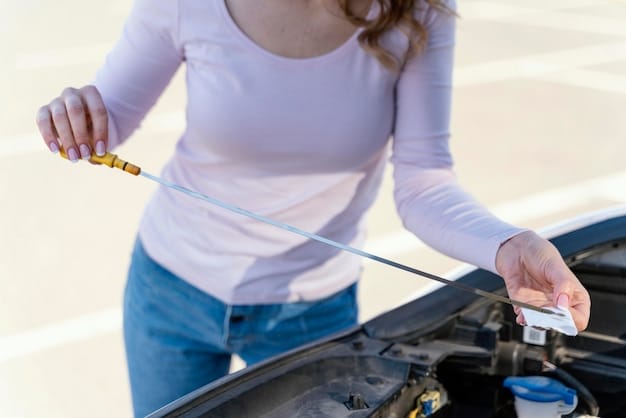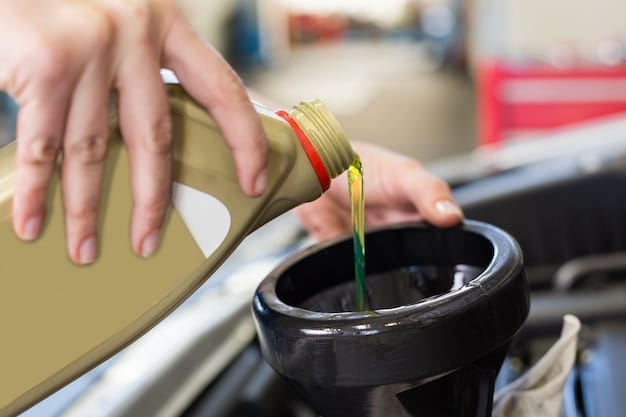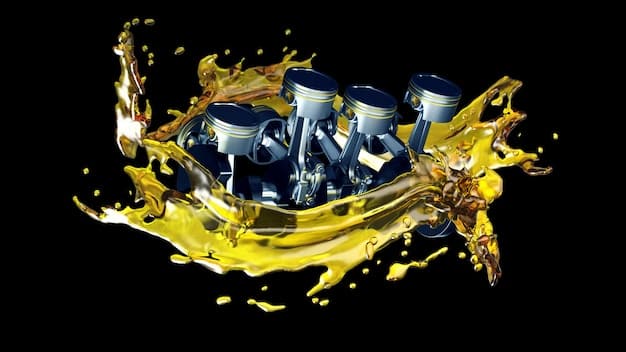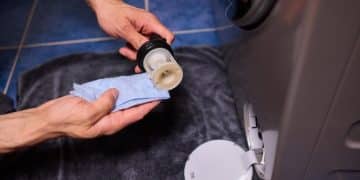DIY Car Maintenance: Save $500 Annually with These Tips

DIY car maintenance can save you $500 or more annually by performing basic tasks like oil changes, tire rotations, and fluid top-ups, reducing your reliance on expensive mechanic services and empowering you to keep your vehicle in top condition.
Taking care of your car shouldn’t always mean expensive trips to the mechanic. By learning some basic DIY car maintenance tasks, you can save upwards of $500 annually and gain a better understanding of your vehicle’s needs.
Why DIY Car Maintenance?
Embarking on DIY car maintenance can seem daunting, but the benefits extend far beyond just saving money. It’s about gaining confidence and a deeper connection with your vehicle.
Understanding the basics allows you to spot potential issues early, preventing costly repairs down the road. Let’s explore some key reasons to embrace DIY car care.
Cost Savings
The most obvious advantage is the substantial savings. Labor costs at auto shops can be significant. By performing tasks yourself, you only pay for the parts and fluids.
Increased Knowledge
As you delve into DIY maintenance, you’ll naturally learn more about how your car works. This knowledge empowers you to make informed decisions about repairs and maintenance.

- Preventative Care: Regular DIY checks can catch minor problems before they escalate.
- Empowerment: Knowing you can handle basic tasks boosts your confidence.
- Customization: You can choose specific high-quality parts and fluids that suit your car’s needs.
Ultimately, DIY car maintenance is about taking control of your vehicle’s health and your budget. It’s a win-win situation that benefits both your wallet and your peace of mind.
Essential Tools and Equipment
Before diving into DIY car maintenance, it’s crucial to have the right tools and equipment. Investing in a basic set will pay off in the long run as you tackle more projects.
Having the necessary tools not only makes the job easier but also ensures you can perform tasks safely and effectively. Here’s a rundown of essential items.
Basic Tool Set
A comprehensive tool set should include wrenches, sockets, screwdrivers, pliers, and a socket wrench set. These are the foundation for most DIY tasks.
Safety Gear
Safety glasses, gloves, and a jack stand are non-negotiable. Protecting yourself from potential hazards is paramount.
- Oil Drain Pan: Essential for catching used oil during oil changes.
- Funnel: Makes it easier to pour fluids without spills.
- Torque Wrench: Ensures bolts are tightened to the correct specification.
With the right tools and safety gear, you’ll be well-prepared to tackle a variety of DIY car maintenance tasks, saving money and gaining valuable experience.
Mastering the Oil Change
Changing your car’s oil is one of the most fundamental and cost-effective DIY tasks you can perform. Regular oil changes are vital for engine health and longevity.
While it might seem intimidating at first, with the right tools and a step-by-step guide, anyone can master this essential maintenance task. Let’s break down the process.
Gather Your Supplies
You’ll need the correct type and amount of oil for your car, an oil filter, an oil filter wrench, a wrench for the drain plug, an oil drain pan, a funnel, and gloves.
Step-by-Step Guide
Start by warming up the engine slightly. Locate the oil drain plug and the oil filter. Position the drain pan under the drain plug, remove the plug, and let the oil drain completely. Then, remove the old oil filter and install the new one after lubricating the rubber gasket with fresh oil.

- Tighten the Drain Plug: Be sure to tighten the drain plug to the correct torque specification.
- Add New Oil: Use the funnel to pour the correct amount of new oil into the engine.
- Check the Oil Level: Use the dipstick to ensure the oil level is within the recommended range.
Changing your oil regularly not only saves you money but also ensures your engine stays in top condition, preventing costly repairs in the future.
Tire Rotation and Maintenance
Proper tire maintenance is crucial for safety, fuel efficiency, and extending the life of your tires. Tire rotation is a simple DIY task that can make a big difference.
Rotating your tires regularly ensures even wear, preventing premature replacement and maintaining optimal handling. Here’s what you need to know.
Why Rotate Your Tires?
Tires wear differently depending on their position on the car. Rotating them evens out the wear, maximizing their lifespan and improving overall performance.
Step-by-Step Guide
You’ll need a jack, jack stands, and a lug wrench. Loosen the lug nuts on all tires before lifting the car. Use the jack to lift the car and secure it with jack stands. Remove the tires and rotate them according to the recommended pattern for your vehicle (usually found in the owner’s manual). Reinstall the tires, tighten the lug nuts by hand, and then lower the car. Use a torque wrench to tighten the lug nuts to the correct specification.
Regularly checking your tire pressure and tread depth is also essential for maintaining optimal performance and safety. Invest in a tire pressure gauge and learn how to read the tread wear indicators on your tires.
By performing these simple DIY tasks, you can save money on tire replacements and ensure your car handles safely and efficiently.
Checking and Topping Off Fluids
Maintaining your car’s fluid levels is a simple yet crucial aspect of DIY car maintenance. Regularly checking and topping off fluids ensures your car runs smoothly and prevents costly damage.
From engine oil to coolant and brake fluid, each fluid plays a vital role in your car’s operation. Here’s a guide to checking and maintaining these essential fluids.
Engine Oil
As mentioned earlier, regular oil changes are essential. But it’s also important to check the oil level periodically and top it off if necessary. Use the dipstick to check the oil level and add oil as needed, ensuring you use the correct type of oil for your car.
Coolant
Coolant prevents your engine from overheating. Check the coolant level in the coolant reservoir and add coolant if it’s low. Use a 50/50 mixture of coolant and distilled water unless otherwise specified in your owner’s manual.
- Brake Fluid: Check the brake fluid level in the master cylinder. If it’s low, add brake fluid that meets the specifications in your owner’s manual.
- Power Steering Fluid: Check the power steering fluid level in the power steering reservoir and add fluid if it’s low.
- Windshield Washer Fluid: Keep the windshield washer fluid reservoir full for optimal visibility.
By regularly checking and topping off your car’s fluids, you can prevent costly repairs and ensure your car runs smoothly and efficiently.
Inspecting Belts and Hoses
Inspecting belts and hoses is another important aspect of DIY car maintenance. These components play a crucial role in your car’s operation, and neglecting them can lead to breakdowns.
Regularly inspecting belts and hoses can help you identify potential problems early, preventing costly repairs and ensuring your car runs reliably. Here’s what to look for.
Belts
Inspect belts for cracks, fraying, and wear. If you notice any damage, replace the belt as soon as possible. Common belts include the serpentine belt and the timing belt (although the timing belt is often best left to professionals).
Hoses
Inspect hoses for leaks, cracks, and swelling. Squeeze the hoses to check for pliability. If a hose feels brittle or mushy, it’s time to replace it. Common hoses include radiator hoses and heater hoses.
Replacing belts and hoses is a relatively simple DIY task that can save you money on expensive repairs down the road. Consult your owner’s manual for specific instructions and torque specifications.
By regularly inspecting and replacing belts and hoses, you can keep your car running reliably and prevent unexpected breakdowns.
Taking on DIY car maintenance is not only a money-saving endeavor, but also provides a deeper understanding and connection with your vehicle, fostering confidence and preparedness on the road.
| Key Point | Brief Description |
|---|---|
| 🛠️ Oil Change | Regularly changing your car’s oil improves engine health. |
| 🔄 Tire Rotation | Rotating tires ensures even wear, extending their lifespan. |
| 💧 Fluid Checks | Checking and topping off fluids prevents costly damage. |
| 🔍 Belt Inspection | Regular inspection of belts and hoses prevents breakdowns. |
FAQ
▼
The frequency of oil changes depends on your car’s make and model, as well as your driving habits. Refer to your owner’s manual for the manufacturer’s recommendations, but a good rule of thumb is every 3,000 to 5,000 miles.
▼
A basic tool set should include wrenches, sockets, screwdrivers, pliers, a socket wrench set, a jack, jack stands, and safety glasses. You’ll also need specific tools for certain tasks, such as an oil filter wrench.
▼
Uneven tire wear is a telltale sign that your tires need to be rotated. Check the tread depth on each tire and look for significant differences. Most manufacturers recommend rotating tires every 5,000 to 7,000 miles.
▼
You should regularly check the engine oil, coolant, brake fluid, power steering fluid, and windshield washer fluid. Keeping these fluids at the correct levels is essential for your car’s performance and longevity.
▼
Inspect belts and hoses regularly for cracks, fraying, leaks, and swelling. Replace them as soon as you notice any damage. Refer to your owner’s manual for the manufacturer’s recommended replacement intervals.
Conclusion
By embracing DIY car maintenance, you can save a significant amount of money each year while gaining valuable knowledge and skills. Start with the basics, invest in the right tools, and always prioritize safety. With a little effort, you can keep your car running smoothly and reliably for years to come.





